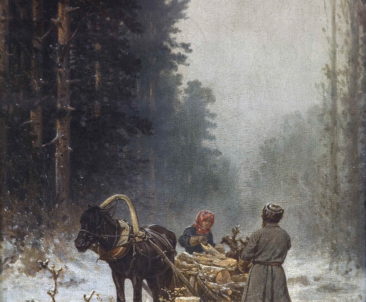

Pyotr Nikolaevich is a painter-battlesist and genre painter.
The artist was born in Kursk in the family of a poor landowner. Since childhood he was fond of painting and independently engaged in drawing, and in 1851 entered the Imperial Academy of Arts in St. Petersburg, in the class of the battalion of Professor BP. Willewalde.
Learning was easy for a young man. Some of the early paintings attracted the attention of academics, moreover, they were awarded medals of gold and silver dignity.
After graduating from the Academy of Arts, Peter Nikolayevich went to Europe. Over the next six years he visited France, Germany, Italy and Austria. During the European period of the life and work of the artist a lot of successful works appeared, which aroused unanimous approval among the ranks of foreign critics. In them, the artist opened up new facets of his talent, describing pictures from French life. He beautifully recreated the plots not only of military operations, but also subtly conveyed all the features and the finest touches of the people’s way of life; however, such a change of activity did not come to the understanding from the Imperial Academy’s superiors, and in connection with this, Gruzinsky was instructed to engage exclusively in battle painting.
In 1865, Petr Nikolaevich went to the Caucasus to prepare sketches for one of his main works “Leaving the aul mountains with the approach of Russian troops.” The canvas made a furore at international exhibitions in London and Vienna, and for him the artist was awarded the title of academician of battle painting. The painter was very good at conveying the drama of war, and, of course, the battle scenes are the most famous paintings of the artist. As a central hero, they are almost always represented by a people glorious in their strength of spirit and therefore invincible.
Gruzinsky, like most of the graduates of the Imperial Academy of Art, devoted his whole life to realism. Looking at his paintings, unwittingly becomes a participant in their events, so clearly and naturally recreated the artist’s compositions and stories of his creations. His landscapes literally breathe the scents of the depicted nature, and the animals imprinted in his works are written out right up to the shine in his eyes.
In the collection of the Voronezh Regional Art Museum. I.N. Kramskoy presents a picture of the “Woodcutter”, in which a peasant and a peasant woman in the winter forest load freshly cut trees onto the wood. Frosty day is slipping towards evening, tired people finish work.
Image: P.N. Gruzinsky The lumberjacks. 1884 (from the collection of the I.N.Kramskoy Art Museum).